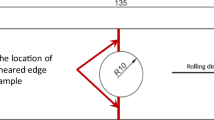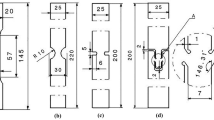Abstract
Edge quality of ultra-high strength sheet blank seriously affects the formability of the downstream edge forming operation such as hole expansion and flanging. Since the influence of damage accumulation caused by blanking is conventionally ignored, the fracture criteria often fail to accurately predict the edge crack. In the present work, a new ductile fracture criterion (DFC) to predict edge cracking of ultra-high strength steel is proposed by considering the damage accumulation near the blanked edge. A new state variable representing pre-damage accumulation is coupled with the conventional DFC to describe damage accumulation. Based on the tensile test data under different blanking conditions, the parameters of the new DFC are calibrated. To verify the new model, flanging simulations are performed to predict fracture strains at edge and compared with experimental results. The new model has the capability of predicting the edge cracking with high prediction accuracy.















Similar content being viewed by others
References
P. Sartkulvanich, B. Kroenauer, R. Golle, A. Konieczny and T. Altan, Finite Element Analysis of the Effect of Blanked Edge Quality Upon Stretch Flanging of AHSS, CIRP Ann-Manuf. Technol., 2010, 59, p 279–282.
J. Wang, T.M. Link, and J. MM, AHSS Edge formability in sheared-Edge tension, in International Conference on New Developments in Advanced High-Strength Sheet Steels, pp. 361–366 (2008)
I. Paetzold, F. Dittmann, M. Feistle, R. Golle, P. Haefele, H. Hoffmann and W. Volk, Influence of Shear Cutting Parameters on the Fatigue Behavior of a Dual-Phase Steel, J. Phys. Conf. Ser., 2017, 896, p 012107.
C. Chiriac and M.F. Shi, Studies on Edge Strain Hardening Produced by Trimming Operations, SAE Technical paper, 2013, p 1774
K. Mori, Y. Abe and Y. Suzui, Improvement of Stretch Flangeability of Ultra High Strength Steel Sheet by Smoothing of Sheared Edge, J. Mater. Process. Technol., 2010, 210, p 653–659.
M. Feistle, M. Krinninger, I. Paetzold, J. Stahl, R. Golle and W. Volk, Design and Conceptualization of a Cutting Tool to Investigate the Influence of the Shear Cutting Process on Edge Crack Sensitivity, J. Phys. Conf. Ser., 2017, 896, p 012106.
B.M. Hance, R.J. Comstock, and D.K. Scherrer, The influence of edge preparation method on the hole expansion performance of automotive sheet steels, SAE Technical paper, p. 1167 (2013)
T. Gläsner, C. Sunderkötter, H. Hoffmann, W. Volk and R. Golle, Development of a 2-Stage Shear-Cutting Process to Reduce Cut-Edge-Sensitivity of Steels, J. Phys. Conf. Ser., 2017, 896, p 012104.
V. Uthaisangsuk, U. Prahl and W. Bleck, Stretch-Flangeability Characterisation of Multiphase Steel Using a Microstructure Based Failure Modelling, Comput. Mater. Sci., 2009, 45, p 617–623.
C. Butcher, D. Anderson and M. Worswick, Predicting Failure during Sheared Edge Stretching Using a Damage-Based Model for the Shear-Affected Zone, SAE Int. J. Mater. Manuf., 2013, 6, p 304–312.
W. Kai, L. Greve and T. Wierzbicki, FE Simulation of Edge Fracture Considering Pre-damage from Blanking Process, Int. J. Solids Struct., 2015, 71, p 206–218.
X. Yu, J. Chen and B. Zhang, Numerical Simulation on Edge Crack of Advanced High-Strength Steel Considering Blanking Induced Damage, J. Mater. Eng. Perform., 2020, 29, p 8286–8293.
J. He, S. Li and L. Dong, Experiments and FE Simulation of Edge Cracking Considering Prehardening after Blanking Process, Int. J. Mater. Form., 2019, 13, p 547–560.
Y.K. Ko, J.S. Lee, H. Huh, H. Kim and S. Park, Prediction of Fracture in Hub-Hole Expanding Process using a New Ductile Fracture Criterion, J. Mater. Process. Technol., 2007, 187, p 358–362.
Y. Bai and T. Wierzbicki, A New Model of Metal Plasticity and Fracture with Pressure and Lode Dependence, Int. J. Plast., 2008, 24, p 1071–1096.
Y. Lou, H. Huh, S. Lim and K. Pack, New Ductile Fracture Criterion for Prediction of Fracture Forming Limit Diagrams of Sheet Metals, Int. J. Solids Struct., 2012, 49, p 3605–3615.
Q. Hu, X. Li, X. Han and J. Chen, A New Shear and Tension Based Ductile Fracture Criterion: Modeling and Validation, Eur. J. Mech. A. Solids, 2017, 66, p 370–386.
X. Hu, X. Sun, L.G. Hector and Y. Ren, Individual Phase Constitutive Properties of a TRIP-assisted QP980 Steel from a Combined Synchrotron X-ray Diffraction and Crystal Plasticity Approach, Acta Mater., 2017, 132, p 230–244.
Y. Lou and H. Huh, Prediction of Ductile Fracture for Advanced High Strength Steel with a New Criterion: Experiments and Simulation, J. Mater. Process. Technol., 2013, 213, p 1284–1302.
M. Zhou, Y. Li, Q. Hu, X. Li and J. Chen, Investigations on Edge Quality and its Effect on Tensile Property and Fracture Patterns of QP980, J. Manuf. Process., 2019, 37, p 509–518.
Acknowledgment
The authors are grateful for the financial support from The Ministry of Science and Technology of China through the National Key Research and Development Project with Grant # 2017YFB0304403.
Author information
Authors and Affiliations
Corresponding author
Additional information
Publisher's Note
Springer Nature remains neutral with regard to jurisdictional claims in published maps and institutional affiliations.
Rights and permissions
About this article
Cite this article
Li, D., Wu, H., Zhan, X. et al. A New Ductile Fracture Model for Edge Cracking Prediction of Ultra-High Strength Steel Considering Damage Accumulation in Blanking Process. J. of Materi Eng and Perform 31, 6880–6890 (2022). https://doi.org/10.1007/s11665-022-06718-3
Received:
Revised:
Accepted:
Published:
Issue Date:
DOI: https://doi.org/10.1007/s11665-022-06718-3




